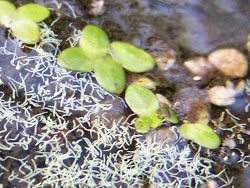I've written many times before about the amazing diversity of life to be found in and around my pond. This week it served up organisms from neither the plant nor animal kingdoms!
 The protist Spirostomum in my pond. (Shown next to lesser duckweed - Lemna minor.)
The protist Spirostomum in my pond. (Shown next to lesser duckweed - Lemna minor.)
The picture shows hundreds of tiny cigar shaped objects which have appeared in their hundreds of thousands (perhaps millions) in my pond over the past few weeks. They are between one and two millimetres in length and no more than a hair's breadth in width. Although they look white in the picture, they normally appear to have more of a greenish-bluish tinge. At first I took them the be something shed from a plant (e.g. seeds) but when I took a closer look they appeared to be moving and I then assumed that they were some sort of worm - perhaps a type of nematode.
When I took a sample of the water and looked at it at 40x magnification (under a binocular microscope), I was taken aback by the high degree of activity of these tiny organisms. Although they appeared to be relatively sedentary when viewed with the naked eye, under the microscope they were revealed as fast moving, gyrating 'animals'. In fact research on the web eventually showed me that they weren't animals at all - neither were they plants! They are almost certainly a species of single-celled ciliates belonging to the genus
Spirostomum of the Kingdom Protozoa or Protists (depending on which classification you adopt).
An excellent
picture of a Spirostomum from the Microscopy UK website bears a striking similarity to what I saw under my own microscope (though at a greater magnification). This web page tells us that "[Spirostomum]
can contract it's body to 1/4 of it's length in 6-8 millisec which is the fastest contraction known in any living cell". I could easily see these lightning-fast contractions as I observed them under the microscope - bunches of them would suddenly contract in unison as if an electric shock had passed through the water and them immediately expand and carry on with their gyrations.
I immensely enjoyed this garden encounter: it is not everyday that you get to easily view, with the naked eye, motile single-celled organisms which are neither plants nor animals. This was a real treat!